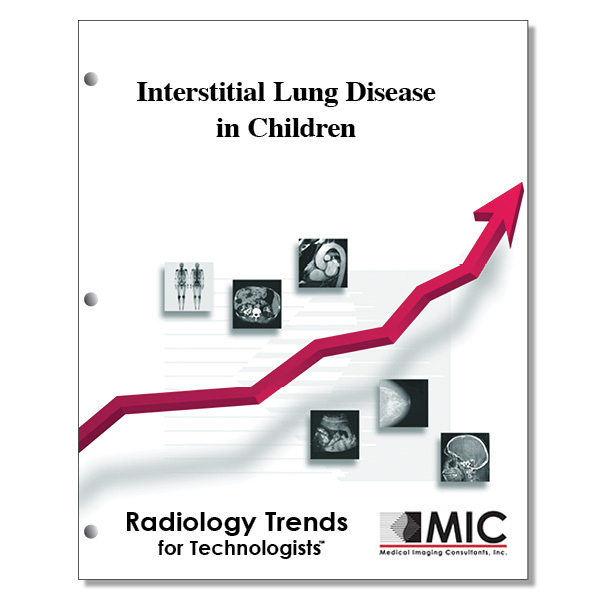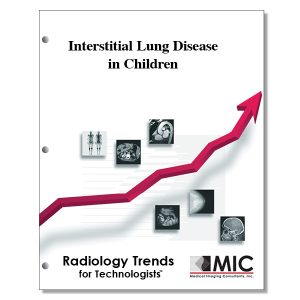

Interstitial Lung Disease in Children
A review of childhood interstitial lung disease and the imaging features of the full spectrum of disorders in the chILD classification system.
Course ID: Q00570 Category: Radiology Trends for Technologists Modalities: CT, Radiography3.0 |
Satisfaction Guarantee |
$34.00
- Targeted CE
- Outline
- Objectives
Targeted CE per ARRT’s Discipline, Category, and Subcategory classification for enrollments starting after December 10, 2024:
[Note: Discipline-specific Targeted CE credits may be less than the total Category A credits approved for this course.]
Computed Tomography: 1.50
Procedures: 1.50
Neck and Chest: 1.50
Radiography: 0.75
Procedures: 0.75
Thorax and Abdomen Procedures: 0.75
Registered Radiologist Assistant: 3.00
Procedures: 3.00
Thoracic Section: 3.00
Sonography: 0.75
Procedures: 0.75
Superficial Structures and Other Sonographic Procedures: 0.75
Outline
- Introduction
- Review of Pulmonary Embryology
- Embryonic Stage (Weeks 4-7
- Pseudoglandular Stage (Weeks 5-17
- Canalicular Stage (Weeks 16-26
- Saccular Stage (Weeks 24 to Term
- Alveolarization Stage (Week 36 to 21 Years
- Imaging Modalities
- Chest Radiography
- Ultrasonography
- Computed Tomography
- chILD Entities More Prevalent in Infancy
- Diffuse Developmental Disorders
- Lung Growth Abnormalities
- Pulmonary Hypoplasia
- Chronic Nenotal Lung Disease
- Structural Pulmonary Changes with Chromosomal Abnormalities
- Specific Conditions of Undefined Origin
- Pulmonary Interstitial Glycogenosis
- Neuroendocrine Hyperplasia of Infancy
- chILD Entities Not Specific to Infancy
- Disorders of the Normal Host
- Infectious and Postinfectious Processes
- Disorders Related to Environmental Agents
- Aspiration Syndromes
- Eosinophilic Pneumonias
- Disorders Related to Systemic Disease Processes
- Immune-related Disorders
- Storage Diseases
- Sarcoidosis
- Langerhans Cell Histiocytosis
- Disorders of the Immunocompromised Host
- Disorders Related to Transplantation and Rejection Syndromes
- Idiopathic Pleuroparenchymal Fibroelastosis
- Disorders Masquerading as Interstitial Disease
- Arterial Hypertensive Vasculopathy: Congestive Vasculopathy, Including Veno-occlusive Disease
- Lymphatic Disorders
- Disorders of the Normal Host
- Unclassified Disease
- Conclusion
Objectives
Upon completion of this course, students will:
- state the reported prevalence of chILD in children under 15 years of age
- recall the respiratory failure rate in neonates with surfactant protein B mutations
- list factors associated with standardized classification that aid in understanding chILD
- list the societies currently classifying interstitial lung disease in the adult population
- explain how the lungs begin development in the embryonic stage
- list the stages of development associated with pulmonary embryology
- state when the first alveolar ducts form
- recall how the alveolar ducts grow in the canalicular stage
- express how many phases there are in alveolarization
- state the imaging modality that is fast, easily reproducible, and inexpensive in the diagnosis of pulmonary disease
- state the imaging modality that is the reference standard for radiologic investigation of interstitial lung disease
- explain how CT for interstitial lung disease diagnosis is performed in patients over 5 years of age
- state what type of CT images are not usually indicated in the assessment of interstitial lung disease and are reserved for difficult cases
- describe how the interlobular septum may appear on CT
- list the phases where developmental arrest can result in acinar dysplasia
- describe pulmonary hypoplasia
- list contributing factors for classic bronchopulmonary dysplasia
- describe how bronchopulmonary dysplasia presents on chest radiography in extremely premature infants
- express pulmonary factors associated with trisomy 21
- list the CT findings for pulmonary interstitial gylcogenosis
- list findings associated with neuroendocrine hyperplasia of infancy
- relate specific gene mutations to related lung disorders
- list the symptoms of postinfectious constrictive obliterative bronchiolitis
- state the percentage of children with chILD that experience chronic aspiration
- recall the approximate percentage of children with systemic sclerosis that have pulmonary disease
- describe Gaucher disease
- describe Niemann-Pick disease
- associate LIP and follicular bronchitis with specific immune diseases
- state the most common disease site form transplant-associated thrombotic microangiopathy to occur
- recall when diffuse pulmonary lymphatic disorders manifest
